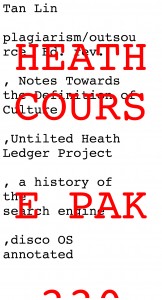HEATH COURSE PAK by Tan Lin | Counterpath Press 2012 | $17.95
HEATH
you have become a very beautiful thing in some
other version of a thing. or you have become a
very beautiful climbing apparatus in a program
about something,
 Riding the GoToBus from Los Angeles to Oakland, I accidentally watched Rush Hour 3 and The Tuxedo from several strategically placed monitors while listening to the Counting Crows, M.I.A. and Meshell Ndegeocello on my headphones. I discovered that Jackie Chan, muted by a randomly generated soundtrack and offset by a variety of backdrops, is still Jackie Chan, in perhaps the same way Heath Ledger is still remembered as Heath in 10 Things I Hate About You (Modern Shakespearean Heath), Brokeback Mountain (Gay Cowboy Heath), or The Dark Knight (Joker-In-Drag Heath). When I wasn’t accidentally watching Jackie Chan fight somebody, I tried to look at the scenery off the 5, which I wanted to believe was more interesting but was in reality less accessible, and ended up accidentally reading incoming and outgoing text messages on the smart phone of a person sitting diagonally across the aisle. This entire experience—me accidentally looking at the mountains, Jackie Chan on mute, someone else’s text messages; you reading this compiled memory as a paragraph on a blog; followers liking, re-blogging, re-posting, sharing and tweeting this review; and then me importing the HTML into Microsoft Word and putting the whole thing through Google Translate a few times—might actually approach the experience of browsing and forgetting that is assembled in Tan Lin’s HEATH COURSE PAK.
Riding the GoToBus from Los Angeles to Oakland, I accidentally watched Rush Hour 3 and The Tuxedo from several strategically placed monitors while listening to the Counting Crows, M.I.A. and Meshell Ndegeocello on my headphones. I discovered that Jackie Chan, muted by a randomly generated soundtrack and offset by a variety of backdrops, is still Jackie Chan, in perhaps the same way Heath Ledger is still remembered as Heath in 10 Things I Hate About You (Modern Shakespearean Heath), Brokeback Mountain (Gay Cowboy Heath), or The Dark Knight (Joker-In-Drag Heath). When I wasn’t accidentally watching Jackie Chan fight somebody, I tried to look at the scenery off the 5, which I wanted to believe was more interesting but was in reality less accessible, and ended up accidentally reading incoming and outgoing text messages on the smart phone of a person sitting diagonally across the aisle. This entire experience—me accidentally looking at the mountains, Jackie Chan on mute, someone else’s text messages; you reading this compiled memory as a paragraph on a blog; followers liking, re-blogging, re-posting, sharing and tweeting this review; and then me importing the HTML into Microsoft Word and putting the whole thing through Google Translate a few times—might actually approach the experience of browsing and forgetting that is assembled in Tan Lin’s HEATH COURSE PAK.
What is HEATH?
plagiarism/outsource Ed. Rev., Notes Towards the Definition of Culture,Untilted Heath Ledger Project , a history of the search engine,disco OS annotated or HEATH, as the project is often referred to, is the revised second print edition of a book authored within a social network. Like following Heath Ledger’s death over the internet—through the rapid replication of speculative information, quotations, paraphrased material, tags and images as they unravel, reproduce and become felt by a social network—Lin’s assemblage of HEATH is a kind of muscle memory for feelings that are erased, re-written, read, scanned and searched repeatedly within a complex system of users, readers, commentators, followers, friends and authors.
Flip through the book once, and the ecology of HEATH shows coffee stains, autographed photos of Jackie Chan and Heath Ledger, images for GSM and RSS, handwritten post cards, post-its, SMS, blacked-out text and pencil markup. A closer look shows cut-and-paste traces of HTML imported into Word, extra line breaks created by absent flash advertisements, links and category tags, click here for details, edit/delete, captured image and text from Google searches, footnotes, text encoding/conversion, markup language, <space></space></CT> and other apparitions and pop-ups. In an interview that appears near the end of the book, Lin says, “These are all just various kinds of writing, where writing extends over a broad spectrum of textual matter and includes things with ‘weak’ author functions […] They all have been outsourced but not necessarily plagiarized, except by some sort of corporate branding structure or legal structure. […] Mistakes, formatting problems, copyright issues, unacknowledged sources are part of text. […] Everything is ‘authored,’ it’s just not clear who.” Continue reading “Review: Tan Lin’s HEATH COURSE PAK”
